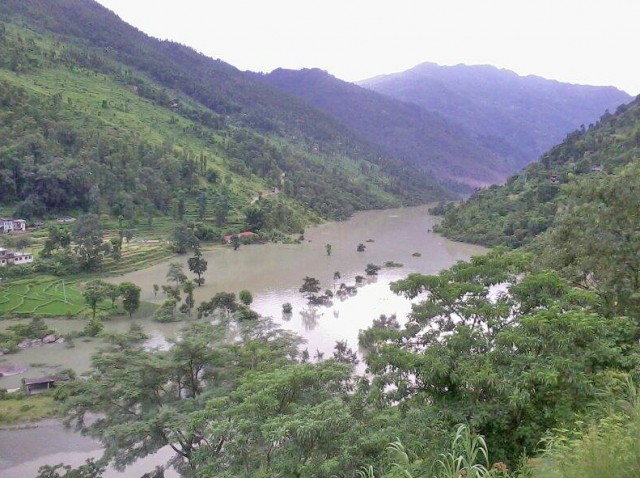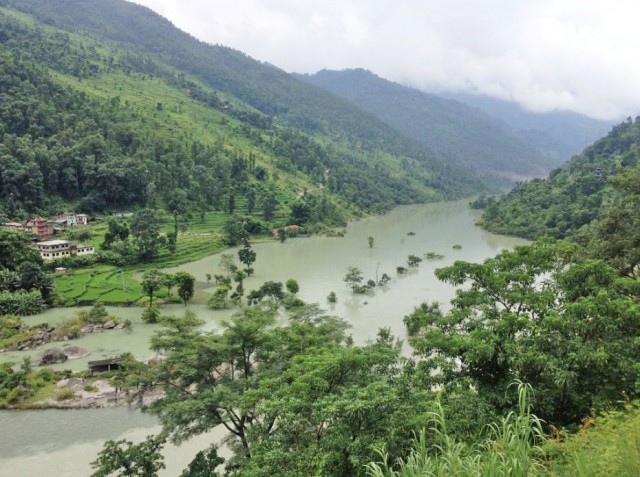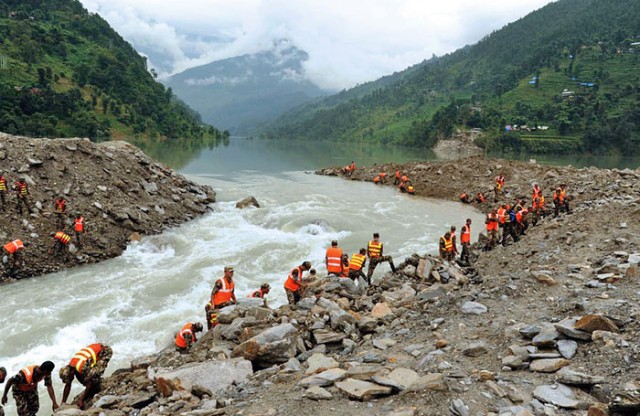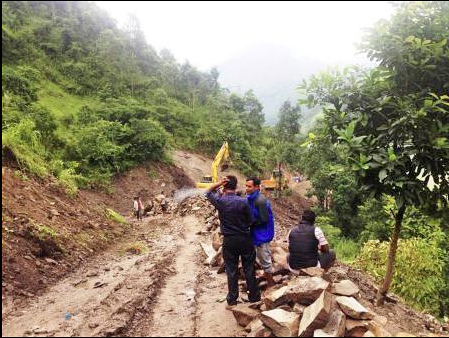24 August 2014
Sunkoshi landslide in Nepal – still no reduction in the lake level
Posted by Dave Petley
Sunkoshi landslide – draining the lake
The Nepal Army is continuing in its attempts to drain the Sunkoshi landslide-dammed lake. Whilst the threat of a breach event has now subsided (though it has not gone completely of course), the major emphasis is on re-establishing the trade link to Tibet. There can be little doubt that considerable effort has been expended, but the results are shown in these two photographs of the lake, tweeted by Kapil Dhital. This is the lake on 6th August:
.
And this is the image he tweeted yesterday – 17 days later:
.
One really does not need to be a trained photographic interpretation expert to see that the lake level has not fallen, despite the best efforts of the Nepal Army. I have done a quick search on the Republica and other Nepal websites for news stories about the lake level behind the Sunkoshi landslide dam:
On 8th August, Republica reported that “The water level in the Sunkoshi River in Sindhupalchowk that increased last Saturday after a massive landslide blocked the river, has started to increase even after the Nepal Army blasted outlets…The water flow in the river was recorded at 180 cusec on the day of the landslide, but now it has reached 300 cusec, Singh said quoting the army technicians.”
On 9th August: “The inflow of water in the artificial lake was 205 cusec while the outflow was 210 cusec, and the water level has decreased by seven centimeters by Saturday, according to a statement issued by NA´s Directorate of Public Relations. The army plans to release accumulated water in the artificial lake, and resume the obstructed Kodari highway at the earliest, the statement added.”
On 10th August: “The water level in the artificial lake formed after the recent landslide occurred at Jure, Sindhupalchowk blocking the Sunkoshi River has increased. The Nepal Army (NA) team carried out three blasts targeting the blocked sites today to ease water flow of artificial lake, said Deputy Superintendent of Police Bharat Bahadur Bohora.”
On 11th August: “If we managed to reduce water level by 10 meters, we can bring the submerged road into operation within another three days,” Sitaula [secretary of the Ministry of Physical Infrastructure and Transport] said. “As the dam was filled in 11 hours, we can drain it out by doubling water flow downstream.”
On 13th August: “Nepal Army on Wednesday carried out eight blasts to resume the regular course of the Sunkoshi River that was blocked following a massive landslide at Jure of Ramche VDC-5 in Sindhupalchowk district on August 2…As per the measurement carried out in the afternoon the internal water current in the artificial lake is 255 cubic sec while the external current stands at 397 cubic sec.”
On 17th August: “The water level in artificial lake formed after massive landslide at Jure blocked Sunkoshi River, is gradually decreasing with increase in water outflow from the reservoir after Nepal Army (NA) constructed another channel to drain out dammed water…According to NA Brigadier General Ashwin Kumar Thapa, the water level has decreased by 75 centimeters after excavators were used to increase water outflow. “The water level in the dam is decreasing at the rate of two centimeters per hour,” he said. He further informed that water inflow in the artificial lake is 180-200 cumec, while outflow of water from the reservoir is 350 cumec “The current water inflow rate is normal rate for Sunkoshi River during Monsoon,” he said. During three-days of torrential downpour both water inflow and outflow were high with outflow and inflow rate standing at 330 cusec and 530 cusec respectively.”
On 19th August a different message emerges: “Although 900,000 kg/meter water is exerting pressure on the landslide dam [note – this statistic cannot be correct for a lake less than 50 m deep], the huge rock material is strong enough to withstand the pressure, the NA said organizing a press conference at its headquarters in Kathmandu. “We cannot open large outlets for the pooled water as that may cause more flooding downstream,” Geologist from the Tribuvan University Ranjan Kumar Dahal said. Also, it is very costly to completely remove the landslide debris, he said. He said it might cost Rs 450 million to remove the whole debris, which is almost impossible. The water level above the landslide dam has so far decreased just by a meter. NA also clarified that it can´t carry any strong blast to make the water exit from the dam.”
On 20th August, eKantipur reported that: “The Nepal Army team, entrusted to drain the landslide-dammed lake in the Sunkoshi river, plans to bring down the water level by 15 metres in the next 30 days, said army officials…“In the last few days, we’ve been able to reduce the level of water by a metre,” said Niranjan Kumar Shrestha, assistant spokesperson for the Army. The Army plans to widen the smaller of the channels currently draining the lake to bring down the water volume.”
On 23rd August the Himalayan Times reported that: “In a bid to ease outflow of water…Nepal Army carried out two controlled blasts on Saturday. NA Directorate of Public Relations said the average inflow in the artificial lake as of this afternoon is 187 cusec whilst the average outflow is 280 cusec”
On 24th August the Himalayan Times reported that: “Issuing a statement on Monday, NA’s Directorate of Public Relations said the Army’s efforts to remove the obstruction…are also ongoing. According the the statement, while the inflow of water in the river was measured at 193 cusec this afternoon, the outflow was recorded at 303 cusec”
In recent days the media has repeatedly reported that the outflow is greater (often much greater) that the inflow. If so the water level should be declining quickly, which is clearly not the case. Thus, the figures must be wrong or misleading, so I am bemused as to why they are repeatedly reported in this way.
The sad reality is that all of the immense effort that has gone into building the two channels has had no impact on the net lake level. The reasons are probably demonstrated in this image from the Nepal Army:
.
Widening the channel is of course no bad thing, but to achieve a drawdown of the lake level behind the Sunkoshi landslide dam the channel bed needs to be deepened. The lake level will not change in aggregate without deepening the channel.
Finally, Kapil Dhital tweeted this image of the private road being constructed by local entrepreneurs:
.
Whilst the frustration that has driven the local people to do this is understandable, the environmental consequences of this road are clear. And, of course, this road will be very prone to landslides, especially as the lake will have elevated the water level in the slopes. I would not want to be on this road is heavy rainfall.






 Dave Petley is the Vice-Chancellor of the University of Hull in the United Kingdom. His blog provides commentary and analysis of landslide events occurring worldwide, including the landslides themselves, latest research, and conferences and meetings.
Dave Petley is the Vice-Chancellor of the University of Hull in the United Kingdom. His blog provides commentary and analysis of landslide events occurring worldwide, including the landslides themselves, latest research, and conferences and meetings.
Outstanding story there. What happened after? Good luck!|